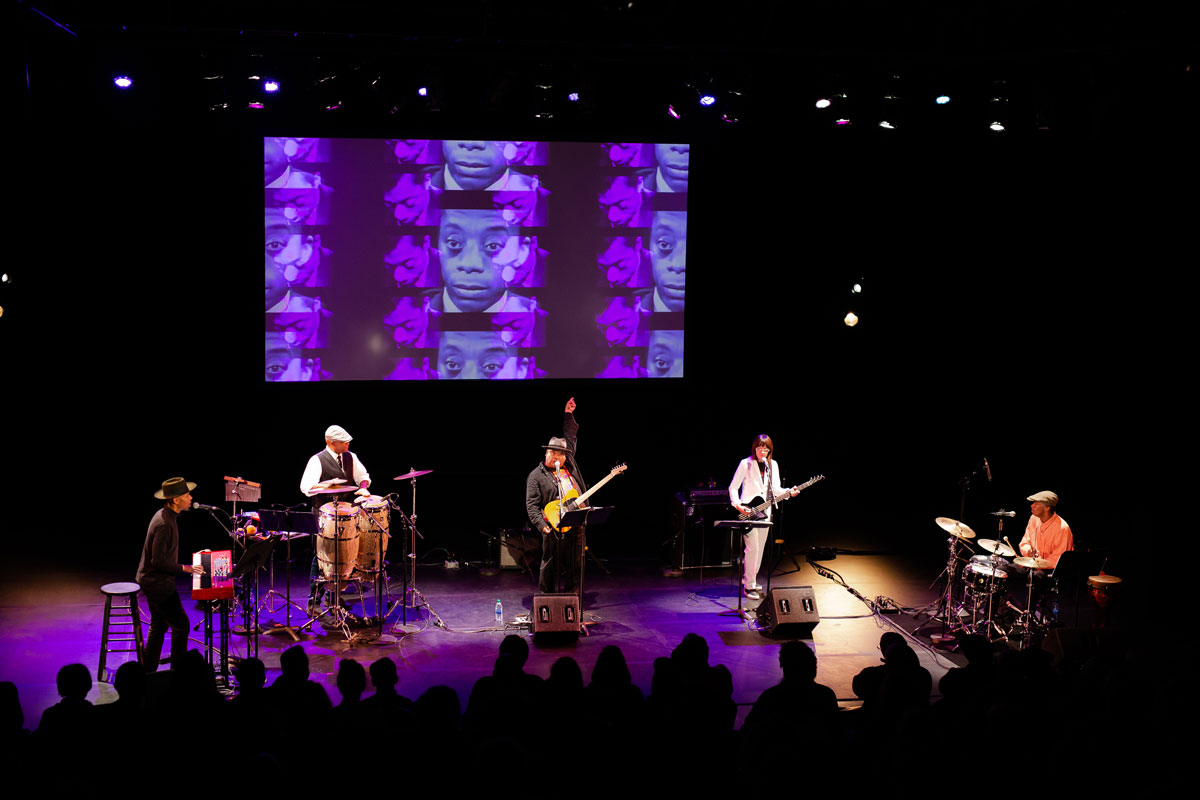
My first Art Wire response that’s in a nonfiction/essay form! Strayed away from my interlinked short stories, though I did try to incorporate it in a separate draft. It didn’t quite shape up the way I wanted it to, and it felt more authentic to respond to it as myself this time.
Inspired by Stew & Heidi, Notes of a Native Song
Inspired by Stew & Heidi, Notes of a Native Song
I’ve taught James Baldwin’s “Notes of a Native Son” more times than I can count. The first time I encountered it was in grad school, during a writing pedagogy seminar at Columbia. I was 23 years old, preparing to teach a required freshman writing course as part of my fellowship. Other than a rigid curriculum that ensured all students came out learning how to write four distinct types of essays (responding to one text; responding to multiple texts; the research essay; and the op-ed), they let instructors choose whatever text they wanted. I came across an old student paper that compared Baldwin’s seminal text with Joan Didion’s “Sentimental Journeys” (the one about the Central Park Five controversy in the late 90s) and Jane Jacob’s chapter on urban safety from her book, The Death and Life of Great American Cities. From the first time I laid eyes on “Notes of a Native Son,” I was immediately drawn to Baldwin’s sentences, the way he flowed from the personal to the political, and the seeming perfection of the essay’s structure. I decided it was high time to bring back these texts that no other instructor seemed to be using.
I started teaching in the fall of 2012. We were in the middle of the Obama presidency. Michael Bloomberg was the mayor of New York—we all made fun of him for trying to speak Spanish in a thick accent. Occupy Wall Street had fizzled out just the year before. The city seemed to have recovered from the 2008 financial crisis. There were cupcake stores on every corner, for some reason. I guess what I’m saying is: New York felt safe, resilient, livable.
At the same time, the New York Police Department had initiated the Stop-and-Frisk program, where they would detain and question suspects on the streets for weapons and contraband. In 2011 alone, the NYPD stopped people over 680,000 times (source: NYT). 90% of those stopped were African-American or Latino, mostly men, mostly between the ages of 14-24. 70% of those stopped were innocent.
It should be noted that Columbia University is located in a neighborhood called Morningside Heights, though it’s actually Harlem. And just a couple blocks beyond the thick Ivy League gates, the young men of Harlem were being stopped-and-frisked every single day.
I—an MFA candidate, about to teach my very first class, about to be paid my very first real paycheck—felt confident walking into that classroom—my classroom—inside the historic Hamilton Hall, named after Alexander Hamilton who attended Columbia back when it was still called King’s College. The classroom was old and wooden, with blackboards on every wall and uncomfortable combo-desks where past students had carved their initials. Before each class, I would reassemble the desks so that we were all in a circle. There were 14 students total. I wore heels and some professorial clothes I found at Uniqlo to try to make myself look older than I was. I introduced myself as Yurina but they insisted on calling me Professor Ko. I never corrected them.
When it came time to dive into the James Baldwin essay, I made them read some paragraphs out loud, starting with the first:
On the twenty-ninth of July, in 1943, my father died. On the same day, a few hours later, his last child was born. Over a month before this, while all our energies were concentrated in waiting for these events, there had been, in Detroit, one of the bloodiest race riots of the century. A few hours after my father’s funeral, while he lay in state in the undertaker’s chapel, a race riot broke out in Harlem. On the morning of the third of August, we drove my father to the graveyard through a wilderness of smashed plate glass.
I made them underline “smashed plate glass.” I told them it was important to remember this image. That it would come back, a few more times, throughout the essay. In the second iteration, Baldwin talks about a time when he threw a glass cup at a white waitress who refused to serve him because of his race. For the first time in his life, the racial tension he’d witnessed like an outsider becomes personal.
There was nothing on the table but an ordinary watermug half full of water, and I picked this up and hurled it with all my strength at her. She ducked and it missed her and shattered against the mirror behind the bar. And, with that sound, my frozen blood abruptly thawed, I returned from wherever I had been, I saw, for the first time, the restaurant, the people with their mouths open, already, as it seemed to me, rising as one man, and I realized what I had done, and where I was, and I was frightened. I rose and began running for the door. … I saw nothing very clearly but I did see this: that my life, my real life, was in danger, and not from anything other people might do but from the hatred I carried in my own heart.
Someone raised his hand. I remember it being a boy. Yes, I was only five years older than my students at the time, but I distinctly remember thinking: boy.
“I don’t know why we’re reading this,” he said. “Racism isn’t a problem anymore.”
To this day, I don’t know if my baffled, improvised response convinced this boy otherwise. I remember trying very hard throughout that semester to get through to him and the rest of these 18-year-olds. I spent hours lesson-planning and commenting on each of their drafts, pushing them to think harder, to consider more perspectives, to incorporate more research. But nothing prepared me to tackle such a confident worldview: “Racism isn’t a problem anymore.”
Imagine being able to say something like this. To inhabit a body that walked through the world thinking something like this.
And I wonder: was it because it was 2012? (But Trayvon Martin had just been killed earlier that year.) Was it because my student was 18 years old? (But Baldwin was 18 when he hurled that glass at the waitress.) As hopeful as I’d been that I could mold these young minds with great pieces of writing, was it always going to be futile sometimes, and I simply wasn’t experienced enough myself for this reality?
*
I kept teaching “Notes of a Native Son” throughout my teaching fellowship. For one semester, I was assigned to the General Studies class, composed of “non-traditional students.” This meant the students were coming back to school after some sort of hiatus. One of my students was once an American Idol hopeful. A few of them were military veterans. A retired ballerina. An ex-con. Their ages ranged from 18 to 45. When we read Baldwin’s essay together, this group didn’t question why I was making them read this in 2013. Many of them lived outside of campus and they’d witnessed Stop-and-Frisk happening right in front of them.
I thought about what non-traditional meant as I taught them all semester. The more I got to know them, the more it seemed to me that these students were more deserving of a Columbia education than the 18-year-olds who had come from privilege and prep schools. I thought back to when I was 18 at Barnard College, the women’s college just across the street. How my professors must have looked at me—at all of us—back then. Book-smart girls who thought they knew it all, simply because they’d done their homework.
After going over Baldwin’s essay, one of my General Studies students raised his hand. He was one of the older ones who had just moved from L.A. “So, Yurina,” he said. “Have you ever listened to N.W.A.? They’re saying what Baldwin’s saying.”
Many of them nodded in agreement. I’d never heard of N.W.A. until that moment. For the first time since teaching, I felt unqualified to be standing up there, writing on that blackboard. Who was I trying to kid, with my heels and pencil skirt?
Later, the student sent me a YouTube clip of “Fuck Tha Police,” an unofficial music video with lyrics scrolling down the page in Helvetica font. I had to pause to read every once in a while because I couldn’t catch up to it the first time. I ended up listening to the whole album on repeat. I went down an internet rabbit hole and found myself listening to other rap artists that I’d sort of heard about, but never actually listened to. Tupac. The Wu-Tang Clan. Run-DMC. A Tribe Called Quest.
It became obvious to me very quickly that these artists, too, were part of Baldwin’s legacy. While I was using Baldwin’s essay and his sentences in an attempt to connect with students, to teach them the power and importance of writing, there was always this music that I’d never known about because I’d never been exposed to it. And why? Because I’d been too busy listening to classical music for most of my own privileged life? Just as I’d thought that 18-year-olds were too young to appreciate college, I thought to myself that 23 was too young to be teaching.
*
I still teach “Notes of a Native Son,” but in a non-academic setting. My students are adults in Nashville, sort of like my General Studies students in that there’s a big age range and a variety of backgrounds and professions represented. The students sign up to take my class simply because they feel like it, not because it’s a requirement for a degree. There’s enthusiasm in the room even before class begins, which is refreshing to me.
I also started teaching in Nashville in 2018, which is a very different world from New York in 2012. Nashville is a blue dot in a very red state. We’re in the middle of a Trump presidency, and Bloomberg has somehow maneuvered his way into becoming a democratic presidential candidate. Instead of cupcakes, we have expensive donuts. On Twitter, it appears the world is ending—environmentally, politically, economically. But in my everyday life in Nashville, I’m a mom to a 2-year-old boy who doesn’t know any of this, whose entire world is about cars, trucks, trains, juice, and bubbles.
I sometimes think about how the world will look to him and my unborn second son who will both grow up as Japanese-Americans in Nashville, where most of his peers will be white. What the world will look like in 2030, 2040. I can only hope that a day will come when my son could say with confidence, “Racism isn’t a problem anymore.”
But then again: isn’t that what Baldwin must have hoped, back when he wrote the essay in 1955?


